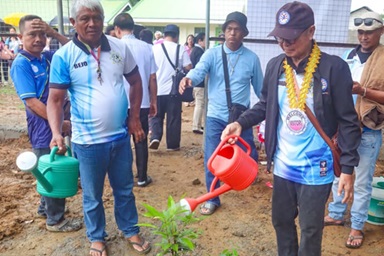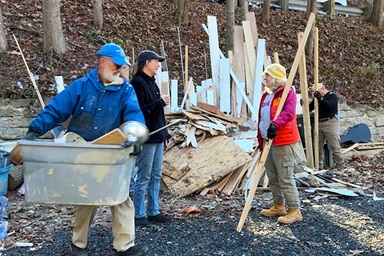Aug. 28, 2014, update
An earthquake-damaged wall at First United Methodist Church in Napa is no longer in danger of collapse but it likely will be a year before the congregation can worship in the sanctuary again.
A quick assessment was possible with the help of Evan Kilkus, a Napa resident who received permission to fly a drone he had purchased over some of the downtown buildings damaged by the Aug. 24 earthquake.
As reported by San Francisco’s ABC 7, Kilkus shared the video both with the Rev. Lee Neish, the church’s pastor, and with structural engineers assessing the damage to the wall.
“That’s what makes this community a real community, when people reach out and help each other,” Neish told reporter Jonathan Bloom.
“The best news so far is that upon initial inspection we will be able to save our stained glass and restore our Sanctuary to its former glory,” the church reported on its website.
In a status report, First Church also noted the individual losses and injuries among Napa residents because of the earthquake and asked church members to “take the time to pray for all who are hurt or who have lost much in Napa, remember them and help those in need.”
The congregation’s traditional Sunday worship service and Sunday School will be held at the Napa Community Seventh-day Adventist Church, which holds its own worship on Saturdays.
First United Methodist Church in Vallejo, which also had some earthquake damage, has been cleared for occupancy.
Earlier story
A 97-year-old United Methodist church was among the historic buildings in downtown Napa damaged by the Aug. 24 earthquake that struck northern California.
Later that day, Phil Bandy, director of Volunteers In Mission for the United Methodist California-Nevada Annual (regional) Conference, met with the Rev. Lee Neish, pastor of First United Methodist Church in Napa and joined the watch over a sanctuary wall that was bulging away from the building.
The wall was in danger of collapse, but Bandy said it was too early to know the extent of the damage. The chair of the building trustees, who was “obviously pretty distressed,” told him the church had been poised to launch a remodeling campaign, Bandy added.
The larger impact on Napa church members from what is being called the strongest earthquake to hit the area in 25 years probably occurred in their personal households, he noted.
First United Methodist Church of Vallejo suffered superficial earthquake damage when some of the brick façade fell onto the sidewalk but “the integrity of the building itself wasn’t compromised,” Bandy said.
After living for 15 years in California, Bandy has become adept at estimating the strength and location of an earthquake by feel. “This was a hard one,” he said. “I was afraid the house might actually come down.”
Although his home was the same distance from the 6.0-magnitude earthquake’s epicenter as Napa was, most of the Vallejo area sits on bedrock, while Napa is built in a sediment-filled valley. “It (Napa) has a much different shake profile,” he explained.
San Francisco Area Bishop Warner H. Brown Jr., and the Rev. Schuyler Rhodes, superintendent of the Bridges District, which includes the affected area, sent prayer and support from Fiji, where they are part of a California-Nevada Conference delegation celebrating the 50th Anniversary of the Methodist Church in Fiji as an autonomous conference.
Coincidentally, the United Methodist Committee on Relief is scheduled to hold a consultation with the conference cabinet and staff in three weeks to review the conference’s disaster response plan.
“We will be thinking preparedness now,” Bandy said.
*Bloom is a United Methodist News Service multimedia reporter based in New York. Follow her at http://twitter.com/umcscribe or contact her at (646) 369-3759 or [email protected].
Like what you're reading? Support the ministry of UM News! Your support ensures the latest denominational news, dynamic stories and informative articles will continue to connect our global community. Make a tax-deductible donation at ResourceUMC.org/GiveUMCom.





